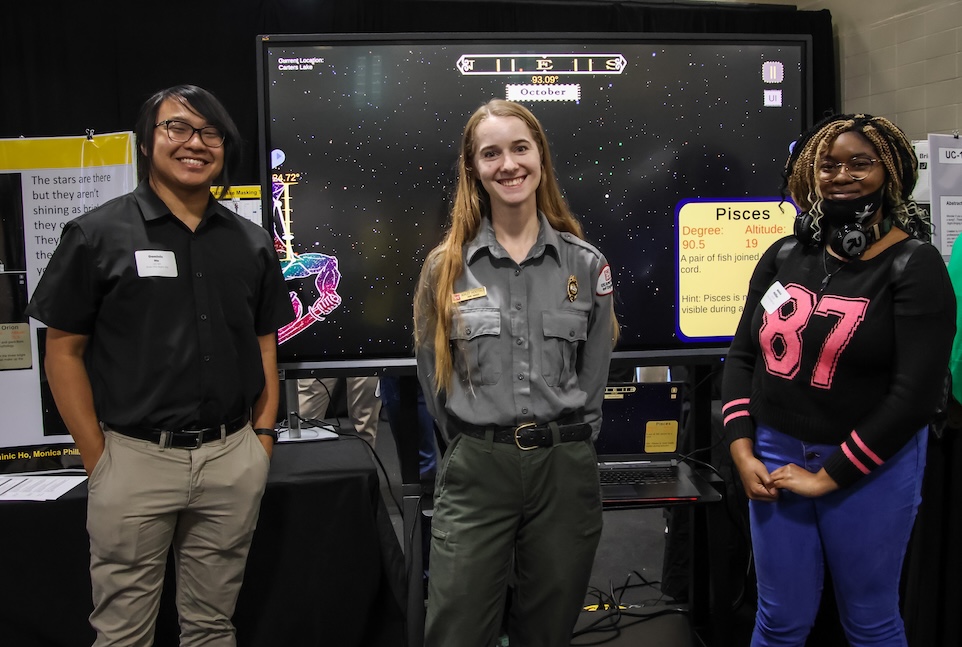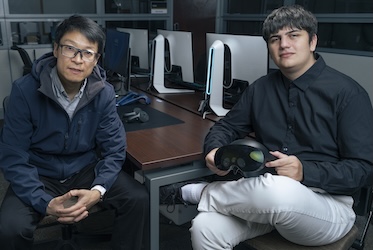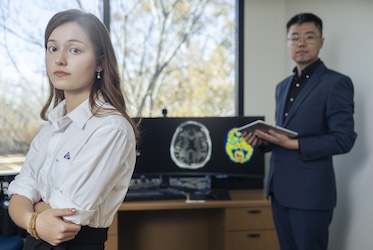

KENNESAW, Ga. | Jul 8, 2025

Created in collaboration with the U.S. Army Corps of Engineers at Carters Lake, the game allows players to explore real-time constellations in a gamified experience built to educate and engage. The project recently earned first place among undergraduate entries at the KSU’s College of Computing and Software Engineering annual C-Day showcase, where it was recognized for originality, usability, and educational value.
“Looking at the stars is always a cool experience,” said Dominic Ho, the project’s lead programmer. “We wanted to go further and give players the ability to interact with the sky, especially kids. Drawing the constellations makes it more engaging.”
The game was created using the Unity software platform with JavaScript for data management. While the original plan included up to 25 constellations, hardware limitations led them to focus on those most visible in the Northern Hemisphere.
When players begin the game, they’re greeted by “Stella,” a glowing celestial guide who helps them navigate their journey. Players can select from various Southeastern locations, each with its unique star visibility. As the sky darkens, players use simple in-game tools like a compass and altitude meter to locate and draw real constellations using data from the Yale Bright Star Catalog.
The catalog proved critical to the game’s scientific accuracy.
“We tried hand-drawing star maps at first, but they didn’t work,” Ho said. “The Yale catalog allowed us to map stars around the player based on time of year and geographic location.”
The team also focused on educational accessibility.
“One of our friends who’s colorblind tested the game and had trouble spotting the stars,” Ho said. “We added a twinkling animation so the target stars would be easier to identify for everyone.”
With artwork by team member Monica Phillips, sound design by Conner Hartsfield, and narrative elements contributed by Richard Deas, the project served as a collaborative effort. Ho also credited teammate Gabe Strong for his user interface design and programming.
Dominic highlighted the mentorship and support that helped bring the game to life.
“George McBroom spearheaded the project. He’s been at the center of all the other collaborative projects with Carters Lake, and it wouldn’t have been possible without his involvement,” Ho said.
Both McBroom and Ashley McKittrick played vital roles in guiding the team and connecting them with the U.S. Army Corps of Engineers to ensure the game’s educational mission aligned with outreach goals.
For Ho, the project was not just about coding or gameplay, it was about learning to trust his team and developing an even deeper appreciation for mythological storytelling in the stars.
“This experience solidified my love for stars and mythology,” he said. “Now I want to build and grow more games.”
Assistant professor of game development Lei Zhang, who provided key mentorship throughout the development of the game, praised the students for their creativity and execution.
"The project is an excellent example of how human-centered, iterative game design and development process has been well executed to create a successful digital application that is truly useful," Zhang said. "I am amazed at the final project outcome and appreciate the amount of work the team spent on exploration and experimentation in the project."
Draw the Night Sky is currently available on Ho’s Itch.io profile. The team hopes to continue finding new ways to blend interactive design with education and storytelling.
– Story by Raynard Churchwell
Photo provided

Discipline and determination drive track and classroom success for graduating student-athlete

Student, faculty researchers explore how AI can improve STEM learning through virtual reality

Student, faculty researchers use AI to improve early detection and diagnosis of Alzheimer's disease

Kennesaw State researchers use drones, artificial intelligence to improve disaster response
A leader in innovative teaching and learning, Kennesaw State University offers undergraduate, graduate, and doctoral degrees to its more than 51,000 students. Kennesaw State is a member of the University System of Georgia with 11 academic colleges. The university's vibrant campus culture, diverse population, strong global ties, and entrepreneurial spirit draw students from throughout the country and the world. Kennesaw State is a Carnegie-designated doctoral research institution (R2), placing it among an elite group of only 8 percent of U.S. colleges and universities with an R1 or R2 status. For more information, visit kennesaw.edu.